EAST HANOVER FLORHAM PARK















BY EVAN WECHMAN STAFF WRITER
AREA - The Hildale Park Presbyterian Church has been a mainstay in Cedar Knolls for many years. The church was built in a park donated to the congregation by elder George Hild in 1917. Though much has changed during the last century, its members have remained dedicated to serving Jesus, the community, and those in need.
Reverend Ross Lang has been leading the direction of the church for a little over nine years. Coming from Pennsylvania and taking over for Rev. Tony MacNaughton, who had been at the helm for over 40 years, seemed difficult initially. However, Reverend Lang will be the first person to tell you how great an experience it has been.
“I’m surprised at how much of a small town feel the church has. Another pastor in the Presbyterian community told
me we are as friendly as other churches say they are in their literature,” Lang proudly said.
He has good reason to feel satisfied with the progress that has been made. Though the congregation only has about 50 members, it has performed a great amount of service during the last few years. For instance, not only do they help collect and distribute food for those in the community, but they are also making an impact internationally.
Reverend Lang is leading the church’s efforts to provide financial assistance and other necessary items to Ukrainian refugees. According to the Reverend, this aid is also critical and personal to him.
“It’s important to me both because we pledged as a church to support Ukraine with (non-military) aid when the war began, we are called by Jesus to welcome strangers and
refugees in our midst, and because our support for Ukraine’s people is contingent on our understanding of the Gospel, not on the Federal Government’s policies,” he said.
For Lang, leading such efforts was not what he originally intended to do as a career when he left his hometown in Bucks County, Pennsylvania for Lafayette College. He and his family were always active in their church, but he was dedicated to becoming a scientist.
While pursuing his studies at college, Lang also spent time with many young Christian groups. Everything changed for him one morning as he had a transformative experience at a Presbyterian church.
“What I found there, on an ordinary Sunday, was people eating and singing together in a manner that completely sidelined their socioeconomic differences: People in expensive

Pics courtesy of Reverend Lang
suits were hugging and singing songs to a raucous piano, with people who had all their possessions next to them in garbage bags,” Lang said.
“They were eating the same brunch, asking about one another’s lives, and seemed to be genuinely close with one another. In worship, they sat right next to each other without any
HANOVER - Celebrating four decades of “bringing music to people and people to music,” the renowned Hanover Wind Symphony will present a gala 40th Anniversary Concert on Sunday, April 27, at 3 p.m., at Morristown High School, 50 Early St., in Morristown. The concert is free and open to the public.
Matthew Paterno of Parsippany, HWS music director, encourages everyone to “Come and join us on April 27 to hear some great music, see some dear friends and celebrate a momentous milestone!”
as a trumpet and cornet soloist.
hint of forming cliques or singling the housing-insecure out.
It was a way of ministering to the housing-insecure that I had never seen before: Not just giving to them, but worshipping with them and knowing them. That was the first time that I felt like full time ministry might be my vocation.”
That morning changed ev-
erything for Lang, which eventually brought him to Hildale Park Presbyterian Church. Though he was initially unsure if the two would be a match, now almost a decade later, he no longer has any doubt.
“It’s been a great experience. I really love the church and the people here,” Lang said.
Michael Baker, trumpet soloist for the 40th Anniversary Concert, has played with the New York Philharmonic, the Metropolitan Opera, the New York City Ballet, and the New Jersey Symphony. He is currently performing with the Philadelphia Orchestra, and he is also a member of the prestigious Brass Band of Battle Creek. The soloist has toured the United States, Japan, Australia, the UK, Canada, Norway, Sweden, and Korea
The Hanover Wind Symphony, a unique extension of the great American tradition of adult music performance, is made up exclusively of woodwind, brass and percussion instruments. The group was founded in 1985 by Peter Boor, who saw the need for an adult ensemble that could perform music of the highest caliber. Boor will be a guest conductor at the 40th Anniversary Concert on April 27. Also serving as a guest conductor will be Ayden Khan of Wayne, HWS associate music director.
from March’s
AREA - The winners from March’s “Find Hank the Hornet Mascot” are Daisy Alexander; Florham Park, Lynda maltino; East Hanover, Sharon Durso; East Hanover and Susan Miano; Florham Park. The ads that “Hank the Hornet” were in: Liliana Cannizzio RE, Duck Donuts, Ideal Air, Bergen Debate Club, 200 Club and Minuteman Limo. Thanks to everyone who enter and congratulations to our winners!

HWS exemplifies the power of music and its influence on our lives. Its highly talented members do not come from the ranks of professional musicians; rather, most are full-time professionals working outside the field of music and include accountants, attorneys, engineers, and corporate executives. Also performing with the symphony are a number of music educators who seek both an outlet for their creative talents and an opportunity to refine their musical skills.
The Hanover Wind Symphony serves the community by playing marches, toe-tappers, and standards while also presenting pieces written by current active composers, some of whom are members of the ensemble. HWS also helps to mentor the next generation of wind musicians by offering scholarships for young people to study with acclaimed musicians at the top of their fields.

gers University, in New Brunswick; the Weis Performing Arts Center at Bucknell University, in Lewisburg, PA; the Community Theatre in Morristown; the Bickford Theatre at the Morris Museum in Morristown; and the Tribeca Performing Arts Center in New York City.
Among the pieces being performed at this grand 40th Anniversary Concert are the following:
• The Home of Creation, by Joe Marta, commissioned by the HWS for their 40th anniversary
• Illuminate, by Andrew Wainwright
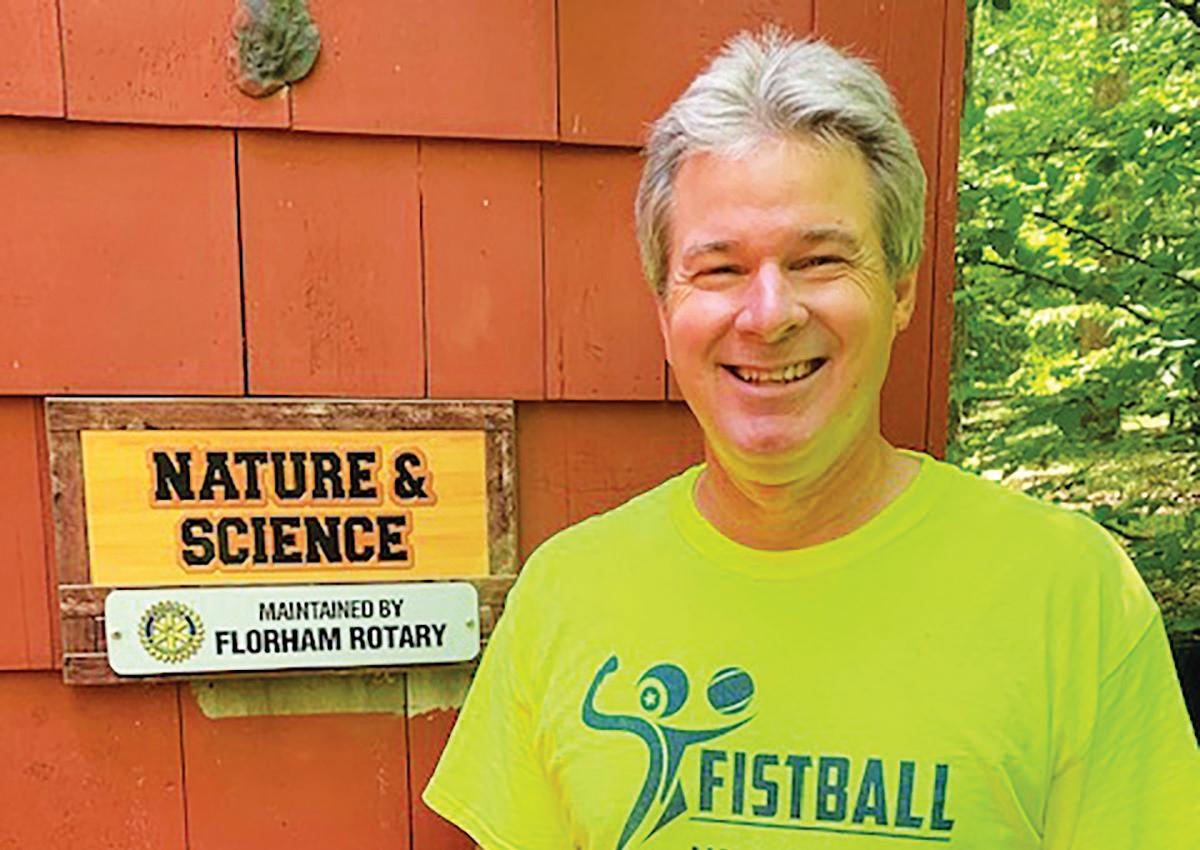
PARK - This sport (some refer to it as «extreme volleyball» or “volleyball on steroids”) dates to the year 240 AD and is of European origin. The International Fistball Association was founded in1960 and is now in 60 countries, including Austria, Australia, Brazil, Germany, India, Switzerland, and the U.S.
ally that is at an already existing handball court is used as a playing field (field size 40 x 20m). Ages range from Middle school through High School, and there are adult leagues as well.
• A Musical Toast, by Leonard Bernstein; arranged by Clare Grundman; Peter Boor, guest conductor
• Colonial Song, by Percy Grainger; Ayden Khan, guest conductor
• Symphonic Concert March, by Giouse Bonelli; arranged by Nicholas Falcone
Bob Feid, a former President of the US Fistball Assn and a Florham Park Rotarian will hold a Fistball intro meeting at the Florham Park Diner, on Friday, April 25, 7:45am8:50am. The meeting is an opportunity to introduce the fast-paced sport to the parents of middle school students and Florham Park students who are in local high schools. Members of the public are welcome to attend the meeting. It is planned as a prelude to actual demonstrations.

• The Belle of Chicago, by John Philip Sousa
• Cosmopolitan America, by Helen May Butler; arranged by Clarence Barber


In addition, the group showcases the work of world-class artists. Some of these soloists have included Joseph Alessi (a trombonist) and Philip Smith (a trumpeter), both with the New York Philharmonic; Patrick Sheridan, one of the world’s most famous tuba players; Steven Meade, a world-renowned euphonium soloist and recording artist; and Dr. Paul Cohen, the world’s premier classical alto saxophone player. For the 40th Anniversary Concert, acclaimed trumpeter Michael Baker will share his talents as a soloist.
The group has performed at various regional venues in the Northeast, including the Boston Festival of Bands at Faneuil Hall in Boston; the New York Brass Conference and Lighthouse International in New York; the Nicholas Music Center at Rut-
• Slavonic Fantasy for Trumpet and Band, by Carl Hohne
• Escapade for Piccolo Trumpet, by Joseph Turrin; Michael Baker, soloist
For further information about the Hanover Wind Symphony, including dates and locations of upcoming concerts, visit www. hanoverwinds.org
Feid hosted the u18 WorldChampionships in Roxbury, NJ, just a few years ago. He is building more US teams for the future and is working with the US Fistball Association to schedule local scrimmages soon.
Each summer (field season), Fistballis played outside on a grass or turf sports field (field size 50 x 20 m). The winter (indoor season) is played in an indoor sports hall. Gener-
“Parents interested in introducing their sons and daughters in middle and high school to a fun, fast-paced sport without the hard physical contact and injuries sometimes occurring in sports like soccer or lacrosse may find Fistball is a great alternative” says Bob Feid. To learn more about the sport, you can check the description, 14 photos, and video in this linke - https://en.wikipedia.org/wiki/Fistball prior to your attending the Florham Park Rotary meeting. Please write to info@flormarkrotary. org if interested and/or may attend the April 25 meeting. Can’t make the Friday, April 25 meeting? Write info@florhamparkrotary.org for more information, or visit one of the weekly Friday morning Florham Park Rotary meetings at the Florham Park Diner. For more info about the Florham Park Rotary, visit the website at www.FlorhamParkRotary.org, Facebook at https://www.facebook.com/ groups/428768947164657, or call Membership Chair George Gregor at 917-848-0982.
Locals and franchise owners Danielle and Tim Sporcic bring three-dimensional learning to families with the opening of The Little Gym of Florham Park added.

Park and East Hanover Community. After establishing roots in their new home, they recognized a need for a space where children could develop physical, social and cognitive skills in a fun, supportive environment.
Seeing this need inspired them to open The Little Gym of Florham Park on January 25th. The Little of Florham Park is in the lower level of Florham Village Shopping Center located
at 187 Columbia Turnpike in Florham Park. Featuring two gyms and party room, the facility with over 6,000 sqft is a great place for kids 4 months through 12 years of age to learn and grow in parent child, Pre-K and Grade School gymnastics classes. The Little Gym also offers camps when school is out, Awesome Birthday Bashes and Parent Survival Nights giving parents an opportunity for their kids to have hours of fun and dinner while they enjoy a nice night out.
Franchise owners, Tim and Danielle, are thrilled to be open and bring the magic of the The Little Gym to the community

where kids don’t have to be the best, they simply have to try their best.
“Our two young children grew up in a The Little Gym, from their initial motor skills as 4 month olds to developing their balance, coordination, risk taking through gymnastics as they grew, we know firsthand the amazing impact it had on them,” Tim said. “These skills go beyond being able to do gymnastics but really create a strong foundation for success in sports, school and beyond. This has been summed up by The Little Gym saying that it acts as the “springboard to life’s adventures,” Danielle
Parents and kids are wel-
come to visit during business hours to speak with the team, learn more about the program and take a tour of the facility.
Classes are already filling up, so families should







































































AREA - Car insurance is a critical aspect of modern life, ensuring that drivers and pedestrians alike are protected from the financial risks associated with accidents, theft, and other unfortunate incidents on the road. But where did this vital safety net originate? To fully appreciate the concept and structure of car insurance as we know it today, it’s essential to delve into the history of the automobile itself and the societal shifts that necessitated the creation of this industry.
The Origins: From HorseDrawn Carriages to Motor Vehicles Before cars dominated the streets, there were horse-drawn carriages. These carriages occasionally caused accidents, leading to damage and injury. While the formal idea of “insurance” existed centuries before cars, with practices like marine insurance in the 14th century, it wasn’t until the invention of the automobile in the late 19th century that the framework for car insurance started to take shape.
The late 1800s marked the
dawn of the automobile era. Early cars, such as those produced by Karl Benz and Henry Ford, were revolutionary but far from perfect. They were expensive, slow, and prone to mechanical issues. However, as more people adopted these vehicles, accidents became inevitable. With limited traffic laws and no real system to determine liability, disputes about damages were common, often leading to legal battles.
The lack of protection for both drivers and pedestrians highlighted the need for a structured system to manage risks. Enter car insurance.
The First Car Insurance Policies
The first recorded car insurance policy was issued in 1897 in the United Kingdom by the General Accident Corporation. This policy focused on third-party liability, covering the damage a driver might cause to others but not the driver’s own vehicle. It reflected the understanding that automobiles, though revolutionary, posed unique dangers not seen with horse-drawn carriages.
In the United States, car insurance took root shortly after. By the early 20th century, automobile use was growing rapidly, particularly due to the success of Ford’s Model T, which made cars more affordable for the average person. With the rise in car ownership came an increase in accidents and property damage, further emphasizing the need for insurance.
In 1898, a policy was issued in Dayton, Ohio, to Dr. Truman J. Martin. This policy, underwritten by Travelers Insurance Company, covered Dr. Martin against liabilities associated with accidents involving his car. Like the British policies, it focused primarily on protecting third parties.
The Legal Push: Compulsory Insurance Laws
As cars became faster and more common, governments began implementing laws to ensure road safety and financial responsibility. One of the significant milestones in car insurance history was the introduction of compulsory insurance laws.
In 1927, Massachusetts
BY RICHARD MABEY, JR. GUEST WRITER
AREA - God loves you more than you will ever know. No matter how tough life gets. No matter the storm winds that seem to envelop you. No matter how hopeless a situation may seem to appear. No matter how bad a medical report you’ve been given by your doctor. Please, please, please remember this eternal truth: God loves you more than you will ever know.
My neighborhood friend, Brad, recently passed away. He lived two streets down from me. He had two little dogs, and it seemed that just about every time that I walked one of my clients’ dogs, he would be walking one of his dogs. Brad and I had a common bond of recollecting old landmarks of Lincoln Park and Mountain View.
As if the odds were a million to one, Brad had once lived in Mountain View, for many years. In many ways, it would always feel as though Brad was one of my close cousins.
Not far from my home, there is this little park. It’s a cozy little park. There’s a horseshoe set up, Bocce ball court, and a shuffleboard court. There’s a good six or seven park benches scattered about this little park. One bench in particular sets just below a tall, towering Live Oak that provides welcomed shade from the hot, Florida sun. Brad and I used to let the pups run free and talk about life in general.
It was about three years ago, sitting on that shady park bench, that Brad broke the news to me that he was diagnosed with cancer. At the time, I had no idea
that I had Hypertrophic Cardiomyopathy. At the time, my Cardiologist was convinced that I suffered from the beginning stages of A-Fib. Brad told me that he recently broke the bad news to his wife.
Brad was a deeply religious man. At the time, during our heart to heart conversations, Brad told me that he wasn’t afraid to die. Brad told me that he knew God loved him. That death was nothing to fear. That it was simply like walking from your living room into your bedroom. It was just that simple. Brad would often say to me, “God loves you more than you will ever know.”
Yesterday, I walked the short distance to my little neighborhood park. I sat in the shaded park bench, where Brad and I would watch our dogs run and play. Brad is gone now, at least from this physical plane. And, I don’t take care of dogs any more. I just got too easily winded, taking the pups for walks. Brad’s insightful words gently echo into my heart, mind and soul, that God loved me more than I would ever know. And, it’s true. It’s very, very true. God loves you more than you will ever know.
In the last couple of months, I’ve had moments where I just wanted to quit everything. To give up writing. To just give up and watch Gunsmoke and Bonanza all day long. But something would stir, deep in the chambers of my heart. That simple statement, God loves me more than I will ever know,

Yours truly with Pepper, one of the many dogs I once cared for and took for walks.
would echo within me. My father would often tell me that my writing, was my ministry.
No matter how tough things may seem. No matter how hopeless your situation may seem. No matter what struggles you are enduring. You simply cannot give up. You absolutely must roll up your sleeves and continue on. Give it all you got. Focus. Let the flame of determination burn brightly in your heart, mind and soul. Never, ever surrender!
Tell yourself a hundred times, no a thousand times, “God loves me more than I will ever know.” Burn that truth into the core fibers of your heart. For it really is true, God loves you more than you will ever know.
Richard Mabey Jr. is a freelance writer. He has had two books published. He hosts a YouTube Channel titled, “Richard Mabey Presents.” He can be reached at richardmabeyjr@ gmail.com.
became the first U.S. state to require drivers to carry car insurance. This mandate was aimed at ensuring that all drivers could compensate others for damages or injuries they caused. Other states soon followed suit, recognizing the importance of protecting their citizens and reducing the burden on courts and individuals involved in accidents.
Compulsory insurance laws also paved the way for the concept of “no-fault” insurance, which emerged in the mid-20th century. Under no-fault insurance, drivers’ own insurance policies cover their damages and medical expenses regardless of who caused the accident. This system was designed to streamline claims processes and reduce litigation.
Innovations and Expansions in Coverage
As the automotive industry evolved, so did the insurance sector. Early policies focused solely on third-party liability, but by the mid-20th century, insurers began offering more comprehensive options. These included:
Collision Coverage: Protecting a driver’s own vehicle in case of an accident.
Comprehensive Coverage: Covering non-collision-related incidents, such as theft, vandalism, or natural disasters.
Uninsured/Underinsured
Motorist Coverage: Safeguarding drivers against damages caused by individuals who lacked adequate insurance.
Medical Payments and Personal Injury Protection (PIP): Ensuring that medical expenses for the driver and passengers were covered after an accident. These developments reflected the growing complexity of modern transportation and the increasing costs associated with vehicle repairs and medical care.
The Role of Technology in Shaping Car Insurance
Technology has always been intertwined with the car insurance industry. Early policies were handwritten, and claims processes were slow and often contentious. However, the advent of computers and data analysis in the mid-20th century revolutionized how insurers assessed risk and handled claims.
Insurers began using actuarial science to analyze historical data and predict the likelihood of accidents, allowing them to set premiums more accurately. Additionally, the introduction of telematics—a system that monitors driving behavior through GPS and sensors—has become a game-changer in recent years. Telematics allows insurers to reward safe drivers with lower premiums, creating a more personalized and fair pricing model.
Modern Car Insurance Challenges and Innovations
The 21st century has brought its own set of challenges to the car insurance industry. With the rise of ride-sharing services like Uber and Lyft, insurers had to develop policies that covered commercial and personal driving scenarios. Similarly, the increasing popularity of electric vehicles (EVs) and autonomous cars has forced insurers to rethink traditional risk models.
For instance, EVs often have higher repair costs due to their specialized components, leading to higher premiums for their owners. Meanwhile, autonomous vehicles—designed to reduce accidents caused by human error—pose questions about liability. If an autonomous car causes an accident, is the driver, manufacturer, or software developer at fault?
To address these challenges, insurers are partnering with tech companies to better understand and adapt to these
emerging trends. Some insurers now offer coverage specifically tailored to autonomous vehicles, while others are exploring blockchain technology to streamline claims processes. Car Insurance Around the World
While car insurance is ubiquitous in many countries, its structure and regulations vary significantly. For example:
In the United Kingdom, car insurance is compulsory, and drivers must display a valid policy to register their vehicles.
In Germany, third-party liability insurance is mandatory, and uninsured driving is a criminal offense.
In the United States, each state has its own regulations, with some requiring only liability insurance and others mandating additional coverage. These differences reflect cultural and legal nuances but also highlight the universal importance of car insurance in modern society.
Car insurance has come a long way since its humble beginnings in the late 19th century. What started as a simple liability policy has evolved into a multi-billion-dollar global industry, offering a wide range of coverage options to meet the needs of diverse drivers and vehicles.
As technology continues to reshape the automotive landscape, the car insurance industry will undoubtedly face new challenges and opportunities. From autonomous vehicles to climate change, insurers will need to adapt quickly to stay relevant and provide the protection drivers expect. In a world where cars are no longer just modes of transportation but also symbols of freedom, innovation, and progress, car insurance remains a cornerstone of modern life—ensuring that the road ahead is as safe and secure as possible for everyone.




















AREA - For 1981 Livingston High School graduate, George Alpert, athletic success abounded.
Alpert, 61, who was born in East Orange but grew up in Livingston, played on successful Livingston Lancer football and baseball teams in his high school career, and he was even drafted by the then Cleveland Indians (now known as the Guardians) of Major League Baseball.
However, for him there was something more important than touchdown catches, successful jump shots (yes, he played basketball as well), and a high batting average and significant centerfield play.
It was more about guys like Stan Yagiello, Greg Wickner, Mike Braun, and many morehis Livingston teammates and friends.
Great players on great teams, but also, as Alpert said, “Great guys.”
Alpert, who attended first Burnet Hills Elementary School and Heritage Middle School prior to Livingston High School, was raised by his parents, George and Joan, and he has a younger brother, Jack, a 1983 Livingston High School graduate who played both football and basketball.
And for Alpert, a guy who excelled so much at both football and baseball, basketball was his first love. He said, “We played basketball all the time,” referring to both his school and Catholic Youth Organization (CYO) schedules. “We had so many games, and it was just a lot of fun and competitive. To play basketball, you’ve got to be tough, athletic, and physical. It
is a great game.”
Alpert lauded all of his coaches who spent time supporting and teaching him during his younger years, but it was his connection early on with Yagiello which translated to every sport both played.
Alpert said, “Both of us were so committed. He was the quarterback in football, I was the receiver; and in basketball, he was the point guard, and I was the shooting guard. Either sport, he was always passing to me.”
Alpert’s basketball playing days and chance at a 1,000-point milestone as a Lancer were cut short by a broken ankle (although he was recruited by Bill Raftery and the Seton Hall Pirates), but his legendary gridiron and diamond career are part of Lancer lore.
“Tony Hope, he was the guy,” Alpert said of the long-

time Livingston Lancer coach. “He said, ‘We’ve got to get you on the football field.’ I remember coming out to practice for football. The first scrimmage game we played, Stan (Yagiello) and I just kept connecting on every play. It was just one after another after another.”
In the fall of 1979, the Al Jacobson-led Lancers finished 9 –2, losing in the state playoffs to powerhouse Union in the finals at Giants Stadium.
Alpert said, “We were fortunate that we had a coach, Mr. Jacobson, that saw talent obviously in Stan and me.” And that connection also led the Lancers to operate on offense differently than most teams that magical fall season. “Nobody threw the ball; everybody was run, run, run, run, run. So, we (the Lancers) said, ‘You know, we’ve got an amazing quarterback, and we’ve got a receiver,’ and so we were throwing the ball. It was so much fun. It was just constant passing, which was what I loved.”
BY STEVE SEARS STAFF WRITER
suffer a 35 – 14 defeat, but in the spring, he would be a significant contributor to head coach Bill Lampeter’s Lancer varsity baseball squad. The team, ranked as one of the best in the nation with Alpert patrolling centerfield, finished 28 – 2 –1. They won every title that season: the Iron Hills conference, the Greater Newark tournament, and the Group IV Section II and Group IV championships.
Alpert, who hit .383 that season, said, “You’ll never take away that championship, and never take away the group of guys that were part of that team.”
For Alpert, a hamstring injury against the West Essex Knights marred his senior season as the 1980 football team would go 6 – 3, and the 1981 baseball team would again win the Iron Hills Conference but lose in the state playoffs.
For his efforts, Alpert was named in both sports to the New Jersey All-State squads as a junior and senior.

1982 and 1983 with Waterloo of the Midwest League, and in his three minor league seasons had 10 homeruns, 132 hits, and 59 runs batted in.
But in the back of his mind, he recalled the Penn State opportunity for a collegiate football career, so to Happy Valley he went.
























Alpert that season was on the receiving end of 52 passes for 789 yards and 11 touchdowns. The Lancers’ schedule culminated in two huge, North II Group IV playoff games at Giants Stadium against the Westfield Blue Devils and the Union Farmers.










“Things were going well,” Alpert said, until an ACL injury ended his football career. “Obviously, injuries are unfortunately part of sports. That was a crippling injury. And there is nothing worse than being injured. You cannot play with the team when you are on the sidelines. There is nothing more frustrating than that.”
However, for Alpert, who graduated from Penn State as a business major, the professional baseball experience was a joy, as was his time as a Nittany Lion. He said, “Penn State – it was like I was a professional athlete, playing before 80,000 people back then. There are regrets, but you move on with your life, and you apply everything that you learned to business world.”














Alpert recalled, “Everybody thought Westfield was going to come out and kill us. The first play the game, Stan and I connected for a 50-yard play, and we beat Westfield (38 – 20). And then we played Union - I think they were ranked #1 and we were #2, maybe, in the state.”
Union had a game plan: limit Alpert’s production by double teaming him, with New Jersey all-stater and future Northwestern star, Mark Ignatowicz, shadowing him.
“Union did a great job defending us,” Alpert said. “They double teamed or triple teamed me every time I split out.”
Alpert and Livingston would
Alpert was visited by many named college coaches while at Livingston, including Penn State head football coach, Joe Paterno. However, the University of Miami was the only school that was going to let him play two sports. He signed a letter of intent with the Florida school to compete in both football for Howard Schnellenberger and baseball for Ron Fraser, while the Nittany Lions left the door open should he ever wish to play football in University Park, Pennsylvania.
But he never went to Miami. After being drafted #13 in the first round of the 1981 MBL draft, Alpert instead headed to upstate New York to play minor league baseball for the Batavia Trojans, a Class A New YorkPenn League affiliate of the Cleveland Indians.
Alpert recalled, “I was a firstround pick, a young 17-year-old kid, and had never been away – it was an adjustment.” After a season in Batavia, he spent
And he did apply what he specifically learned in college to the business world. Alpert nowadays is the owner of two car washes, Caldwell Car Wash in Caldwell and Union Car Wash in Union (http://caldwellcarwash.com/)
Alpert and his wife, Loriwho is the Creative Director and Co-owner of a global fashion modeling agency called IconicFocus (https://iconicfocus. com/) - were married in 1994, and they are parents of a daughter, Samantha, and a son, Lucas.


BY HENRY M. HOLDEN STAFF WRITER
of West Jersey which included Morris County, and the area later called Shongum. Penn never visited the land since he was literally on his deathbed ill and living in England. At the time of his death, he left his children to develop Shongum.
The name Shongum is an Indian derivation. In 1935 historian and Indian expert, Reginald Pelham Bolden, stated that the word Shongum is a corrupted version of the words N’ashaue and Gunnuak meaning midway between or high place.
From the 1600s to the mid1800s the construction and the operation of a forge remained standardized.
The name Forge is somewhat misleading in the sense of the word as we use it today. It is more properly called a bloomery, and the person operating it is called a bloomer.
Between 1758 and 1773
ly be Randolph Township. It played a important role in the development of Shongum.
When the bloom was removed from the hearth, and while still hot, it was hammered in the early days with sledgehammers. Later a trip hammer driven by waterpower was used.
The heat of the fire was increased by the air coming from the bellows.
The bloomer stirred the hot mass using a stick of green wood which gave off more carbon monoxide as it charred. More and more of the growing iron particles came together and formed a spongy mass of iron, interlaced with veins of slag. This mass is called a bloom, and the forgers often spoke of the bloomery. Later, power-driven rollers and squeezes were devised which would make the job faster and more evenly.
The finished product was wrought iron, and it was made from the iron from the Succasunna mine and in abundance around what would eventual-
At one time, several centuries ago Morris County and Shongum were heavily forested. As the human population increased some of the forests were stripped to make charcoal which in turn produced a heat that could be used to fashion iron products. Waterpower, generally coming from man-made dams required to work a large bellows above the hearth to carry off the fumes and smoke. The forge was a hearth with a hood and earlier forges were made of stone or brick.
Two other ingredients essential to the forge operation were waterpower and charcoal. The ore, flux, and charcoal were heated in a hearth. Oxygen, to make the mix heat more rapidly was forced into the hearth through an opening called a tuyer. This bellows was operated by power supplied from a water wheel. After a few hours the proper temperature was reached and the iron started to melt.
With the constant reheating of the bloom, (this process could go on for days) until iron had been worked into a form of a “merchant bar.” The bar was three inches wide, one and 1/2 inches thick and four or five feet long. It could be then melted, and shaped into usable articles that or sold, as is to other processors.
To remove the impurities tremendous force was needed.. This was accomplished by means of cams attached to the water wheel. They were connected to a huge log about 13 feet long. When the hammer was raised and released gravity brought it down on the anvil and bloom with approximately 500 pounds of force.
Great Britain placed restrictions on the forge operators, and products made on the forges. It became illegal to process the iron bars which had to be shipped to England where they were processed and sold back to the Colonists as manufactured articles such as shovels, axes, saws, etc. This would become one of the underlying causes of the rebellion.
The Dan Brook, which had its beginning north of Mount Freedom, was, and is an important feature of the landscape of Shongum. It was damned to form the 24-acre pond, which was the forerunner of Shongum Lake. This pond, referred to in early deeds and maps, as Shongum Pond formed the reserve of waterpower used in the operation of the forge and also a sawmill, which was built lower down on the stream.
In earlier days, the local, Minsi Indians, use the banks of the stream for a branch of their trail, which ran from Minisink in the Delaware River to Naversink at the Jersey shore.
In 1769 an important event took place in the area. The road which is now called Shongum Lake Road and Shongum Road was completed. This first portion began at the top of the
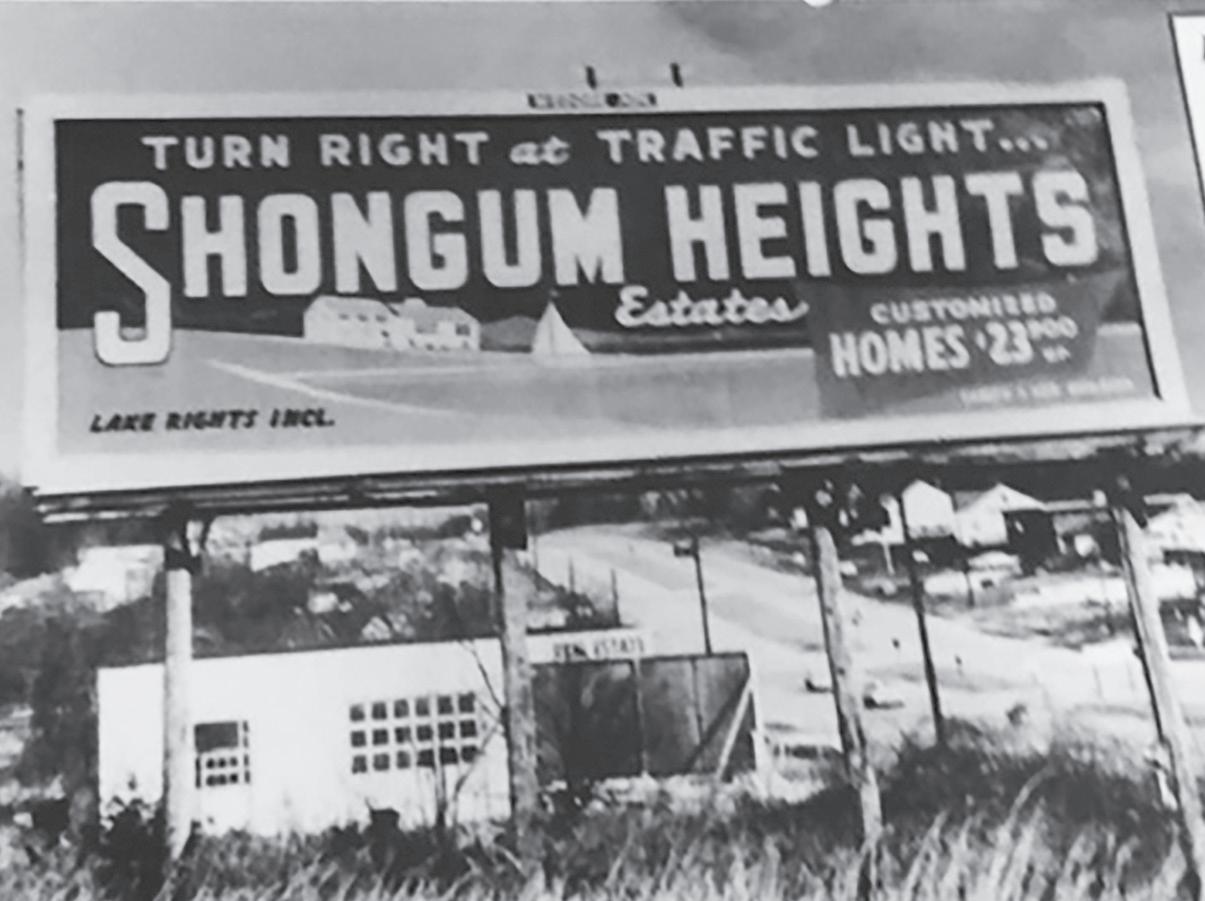
mountain in the Succasunna (Hanover Avenue) Plains in the middle of the road that leads from Morristown to Suckasunny plains . It was four rods wide (66 feet) and passed the Shongum Pond and ended at a certain apple tree in the lane on the southwest side of Robert Youngs orchard. This would place the ending where the present Openaki Road begins.
The second portion began at the same apple tree and continues for 2.6, miles and ends on the road that leads from Millbrook to Skooleys Mill.
Building this road allowed the mine operators easy access to the roads leading to the Succasunna mine, forge and iron markets.
On May 20, barely two months before the Declaration
of Independence work began on the road from Shongum forge to Suckasunny plains which extended the road. It crossed the road leading from Mt. Freedom to Dover west of the Friends Meeting House (Center Groove Road). Today, a visitor from two centuries ago would not recognize the Shongum he knew. The lake is surrounded by upscale housing and there are roads leading to 27 historic sites in Randolph. The Shongum forge served from 1758, through the War for Independence, and closed in 1823, a span of 65 years. It was situated below the Shongum Lake dam. Today the site is a parking lot for the Shongum Lake Property Owners Association.
AREA - Board Members of the New Jersey State Association of Chiefs of Police (NJSACOP) made a special visit to the Tomb of the Unknown Soldier at Arlington National Ceremony on Feb. 25, laying a wreath to remember and honor those unidentified service members who made the ultimate sacrifice.
Under the close direction of the U.S. Army’s 3rd U.S. Infantry Regiment, known as “The Old Guard,” NJSACOP members quietly descended the stairs of the Memorial Amphitheater at the symbolic grave and offered the floral tribute, symbolizing the beauty and brevity of life. “We were honored to be here to pay our formal respects to America’s unidentified heroes,” said NJSACOP President John Russo, chief of the Rutherford Police Department. “This is a sacred place of mourning overlooking the U.S. Capitol in the distance. It was an incredible experience to be at this site with my fellow police chiefs, reflecting on the enormous sacrifices connected to military service, valor and, sometimes, loss.”
rarily at the tomb, a white marble sarcophagus that has been a symbol of sacrifice and service at the cemetery since 1921.
Four of the 10 NJSACOP delegates took part in the laying of the wreath: Russo, NJSACOP First Vice President and Montville Police Chief Andrew Caggiano, NJSACOP Second Vice President and Collingswood Police Chief Kevin Carey and NJSACOP Third Vice President and Elizabeth Police Chief Giacomo Sacca.
Staff Sgt. William Matyas, an impeccably uniformed member of the Old Guard who led the wreath-laying event. The 35-year-old career soldier was eager to answer questions, pose for photos and explain the disciplined life of a sentinel.
ance. The Sentinels wear the Army dress blue uniform, reminiscent of the color and style worn by soldiers during the late 1800s.
The wreath included a white banner that read “New Jersey State Association of Chiefs of Police.” It was placed tempo-
Following the ceremony, the NJSACOP members were invited into the Old Guard quarters underneath the Memorial Amphitheater, where they met with
Sgt. Matyas explained how the Tomb Guards work on a three-relief rotation; each relief has one commander and about six Sentinels. The three reliefs are organized by height, so that those in each guard change ceremony look similar in appear-
Every day, Tomb Guards march exactly 21 steps down the black mat behind the Tomb, turn, face east for 21 seconds, turn and faces north for 21 seconds, then take 21 steps down the mat and repeats the process. (The number 21 symbolizes the highest military honor that can be bestowed, the 21-gun salute.)
Next, the Sentinel executes a sharp “shoulder-arms” movement to place the weapon on the shoulder closest to the visitors, signifying that he or she stands between the Tomb and any possible threat. The Sentinels stand watch 24 hours a day, 365 days a year, in any weather. Sentinels, who volunteer for this post, are considered the elite of the elite 3rd U.S. Infantry Regiment, the oldest active-duty infantry unit in the Army, serving the United States since 1784.
AREA - Catherine McCall, a spiritual medium, is being hosted by the Chester Lioness Lions Club at a special event on Sunday, April 27, 2025. With many years of experience and her intuitiveness, McCall bridges the physical and spiritual realms offering comfort, healing, and closure to those seeking answers or reassurance about loved ones who have passed on. Her compassionate readings provide insights into personal journeys, relationships, and messages from the other side, making this event a transformative experience for all who attend. The event will be hosted at the Colonial Prospect Hall at 370 Main Street, Chester, New Jersey, from 1:00 pm to 4:00 pm, with doors opening at 12:00 pm. A light lunch will be served.
Tickets for the event are $45 and can be purchased on the club’s website, chesterlioness. org, or via their Facebook page, facebook.com/chesterlionessclub.









BY RICHARD MABEY, JR. GUEST WRITER
AREA - Sometimes, it’s hard for me to believe that it was only about a year and half that I had a rather successful dog walking business, in my neighborhood. Altogether, I had about 20 clients. When I was diagnosed with Hypertrophic Cardiomyopathy, back in December of 2023, my Cardiologist highly recommended that I give up my little business. On busy days, I was walking a good five or six miles a day, taking the little pups for their walks.
Lately, I find myself thinking, more and more, about the dogs who have touched my heart and life. Sadly, some
have passed away. Some of their mommies and daddies have moved away, and I know I will never see those little dogs ever again. During my morning devotional time, after I’ve read a few pages of the Holy Bible, I pray for the dogs to whom I looked upon as friends.
And lately, I’ve been thinking a lot about Little Snowball. She was a little pupper, all white in color. A most happy dog. A bit high strung, but for some reason, she would calm down whenever I would take care of her.
Little Snowball’s daddy and mommy were Ted and






Jean. They were both in their early eighties. They lived on the next street over from me. They would frequently drive out to a little town in North Carolina to visit with their daughter and son-in-law, for about a week at a time. They were very kind people and I would stay at their home and take care of Little Snowball, while they were away. I think that Ted had a very good pension, because they would always pay me very well for my time of taking care of Little Snowball.
In June of 2023, Ted went Home to be with the Lord. He had, had a heart attack.




It was only a few days after Ted passed away that Jean’s daughter helped her mother pack up her stuff. They had a big garage sale. I bought one of Ted’s books, Ernest Hemingway’s first novel, “The Sun Also Rises.” I cherish it.
Right after they had their big garage sale, Jean put the house up for sale and moved to North Carolina to live with her daughter. It was very, very sad to say goodbye to Little Snowball. For I knew, in my heart of hearts, I would never see that adorable little puppy ever again. Sometimes life just isn’t fair.
About a week after Jean moved away, I received an email from her. She told me that she and Little Snowball were doing well. And, that they had plans to visit Mount Airy, the real Mayberry. I had often talked about the real Mayberry with Ted and Jean. They had never visited there at all.
I wrote Jean back and told her that I was happy that she and Little Snowball were happy in North Carolina. I made a little joke to Jean that she needed to be careful driving in North Carolina, that there was a nervous Deputy Sheriff (namely Barney Fife) there that had given his own mother a speeding ticket. Sadly, I never heard from

Jean again. I was going to write her again, but thought that it was best not to push on the door.
The old adage, when one door closes, another one opens, is all so very true. I now am focused on educating as many people as I can possibly reach, about the detailed intricacies of Hypertrophic Cardiomyopathy. Just last week, my General Practitioner complimented me that she thought I probably knew more about HCM than most Primary Physicians know. I told her that I read and study, the latest cutting edge trials of HCM, anywhere from an hour to three hours a day. HCM is the single
most difficult heart disease to diagnose. It is a silent killer. Hold dear to your Divine Purpose. Be true to the calling that God has placed in your heart. Falter not. Be not distracted by the nay slayers. Hold a love for all living things, deep within the chambers of your heart. Never abandon your dreams. Never give up! Never, ever surrender! For with God, all things are possible. Richard Mabey Jr. is a freelance writer. He has had two books published. He hosts a YouTube Channel titled, “Richard Mabey Presents.” He can be reached at richardmabeyjr@gmail.com.








BY DANA JACKSON
Q: Who is the actor playing “Daredevil” in the new series on Disney+? What else has he been in? -- E.O.
A:Charlie Cox was born in London and studied drama there before landing his first on-screen role in 2001 in the BBC series “Judge John Deed.” He followed this with the 2004 film adaptation of “The Merchant of Venice,” starring Al Pacino and Jeremy Irons. His first big American series was HBO’s “Boardwalk Empire,” where he played Owen Sleater before landing the lead role in the Netflix series “Daredevil” in 2015. It was canceled after three seasons, but Disney+ recently launched a new spinoff called “Daredevil: Born Again,” with Cox reprising his role.
Next up for Cox is the Amazon rom-com flick “Merv,” opposite Zooey Deschanel, about
BY DEMI TAVERAS
“The Residence” (TV-MA)
-- This whodunnit series hails from the production company Shondaland, which is run by television guru Shonda Rhimes (“Scandal,” “How to Get Away with Murder,” and many more).
Led by the charming Uzo Aduba (“Orange Is the New Black”), the eight-episode show follows detective Cordelia Cupp as she’s tasked with a murder that occurred during a state dinner in the White House. With the victim being the White House Chief Usher A.B. Wynter (Giancarlo Esposito), Cordelia must inspect 157 suspects, investigate about 132 rooms, and keep the White House from falling into complete disarray. Sounds easy enough, right? All eight episodes premiere March
a couple who reunite to take their depressed dog on a vacation to Florida.
*** Q: I read that Jen Shah from “The Real Housewives of Salt Lake City” will be getting out of prison early. Have there been any other “Real Housewives” besides Shah and Teresa Guidice who have gone to prison? -- L.S.
A:Jen Shah and Teresa Guidice (of “The Real Housewives of New Jersey”) are the only two Bravo network Housewives to serve time in federal prison, but several others have been to jail. Kim Richards, formerly of “The Real Housewives of Beverly Hills” franchise, was arrested at the Beverly Hills Hotel for public intoxication and other charges in 2015. Four months after this, she spent a night in jail for shoplifting from Tar-
20. (Netflix)
“Good American Family” (TV-MA) -- This limited drama series has two heavy hitters in television -- Ellen Pompeo of “Grey’s Anatomy” fame and Mark Duplass from shows like “The Mindy Project” and “The Morning Show.” The two leads were great picks to take on the controversial subject matter in this story. A dramatized version of Natalia Grace’s real life, this series follows 7-year-old Natalia (Imogen Faith Reid), a girl with dwarfism who gets adopted by Michael and Kristine Barnett. As the Barnetts welcome her into their family, they notice certain oddities with her, which lead them to think that she isn’t actually a young girl but a full-fledged
get. She avoided any further jail time by going to rehab and being put on probation until 2018.
Luann de Lesseps was arrested for battery and disorderly intoxication in 2017 in Florida while she was a cast member of “The Real Housewives of New York City.” She’s famously quoted as saying to the camera: “I’ve been traveling. I’ve been to prison.” She spent one night in jail on Christmas Eve for the arrest, then went to rehab twice.
The most recent Housewife arrest and sentencing is Karen Huger of “The Real Housewives of the Potomac,” who wrecked her car and was charged with a DUI in 2024. She’s currently serving a oneyear sentence at a county correctional facility in Maryland.
***
Q: I thought the new reviv-
adult pretending to be a child, a la “Orphan” (2009). The first two episodes will be released on March 19. (Hulu)
“Happy Face” (TV-MA) -- This true-crime drama series was adapted from Melissa Moore’s real-life story as the daughter of the “Happy Face” killer Keith Hunter Jesperson. Using excerpts from her podcast of the same name, as well as her autobiography “Shattered Silence,” this eight-episode series recounts how Melissa (played by Annaleigh Ashford) is forced to reconnect with her serial killer father who is in jail for his heinous crimes. Ready to go public about the reasons behind his crimes, Happy Face claims that he will only speak to Melissa about the crimes he
al of “Frasier” had been canceled, but now I’m reading that Kelsey Grammer says it will be back. Is this true? -- R.R.
A:Yes, the “Frasier” reboot was recently canceled after two seasons by Paramount+. I think the obvious reason it never caught on like the original series was that it was missing three very familiar faces: David Hyde Pierce as Niles, Jane Leeves as Daphne, and sadly the late John Mahoney as Martin.
Star Kelsey Grammer is hopeful that another streamer or network will pick it up. In fact, he’s confident that “Cheers” star Ted Danson will also co-star or at least appear on the series. It’s a lot to wish for, but if it happens, I think the viewership will follow the series to its new home.
Send me your questions at NewCelebrityExtra@gmail.
committed. But Melissa must be careful not to let his wickedness and their bond as father and daughter eclipse her judgment. Dennis Quaid, who’s been thriving in villainous roles lately, stars as the Happy Face killer in this series premiering March 20. (Paramount+)
“Picture This” (PG-13) -For their latest original film out now, Amazon Prime enlisted the help of two actors who were sure to bring this rom-com to life: “Bridgerton’s” Simone Ashley and “After’s” Hero Fiennes Tiffin. Ashley stars as photographer Pia, who receives a prediction from a spiritual guru that she will meet her true love within her next five dates. Her newly engaged sister runs to set up Pia on dates so that Pia can

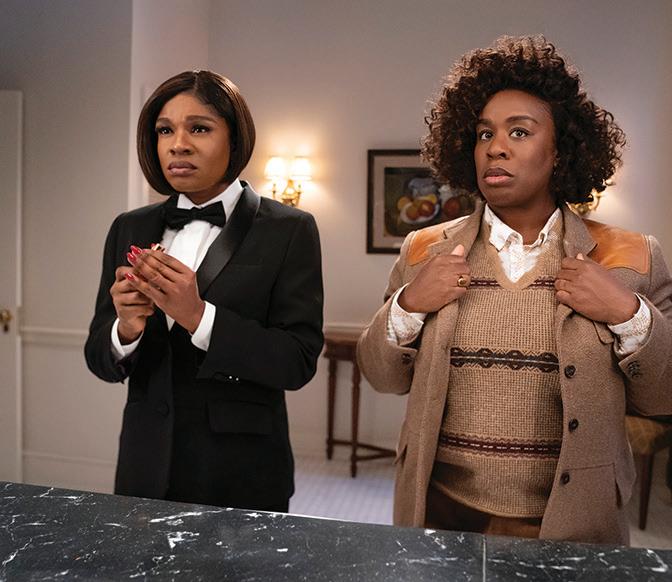
meet her new love in time to bring him to the wedding. But when Pia’s ex Charlie (Fiennes Tiffin) reappears out of the blue, Pia becomes laser-focused




















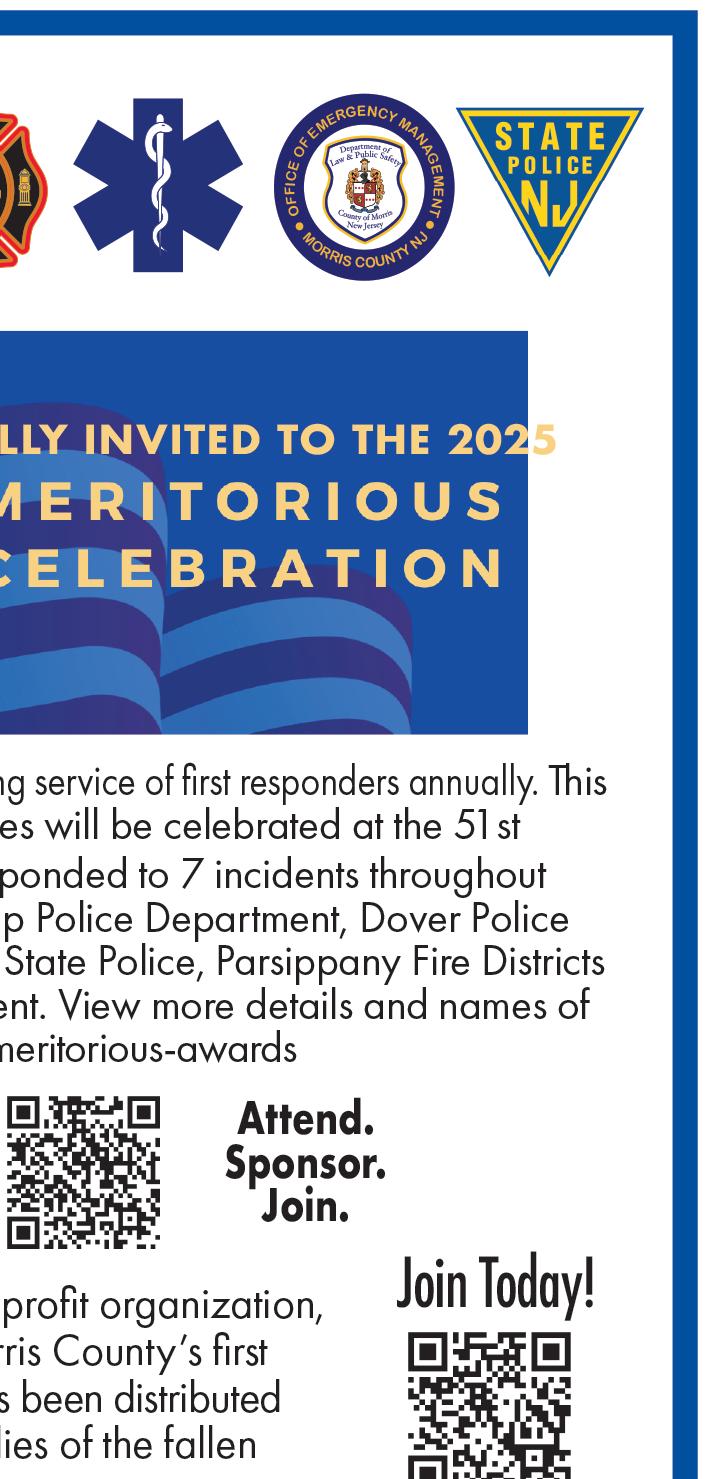









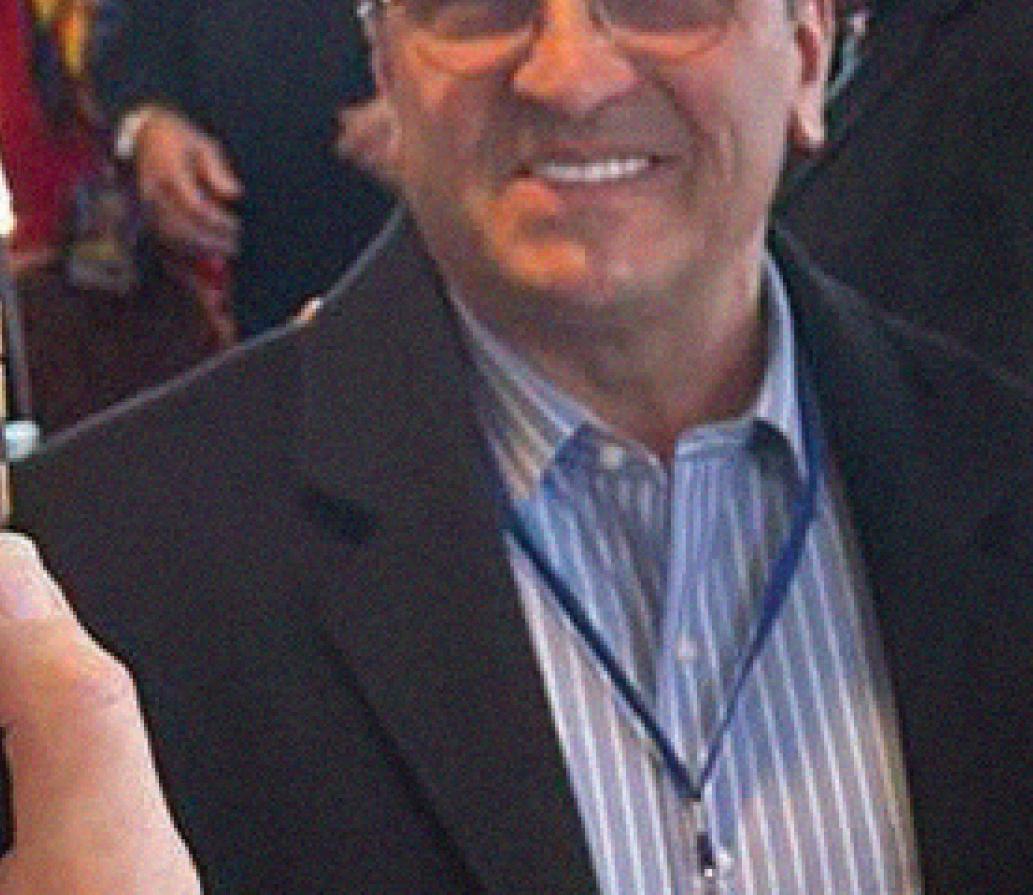
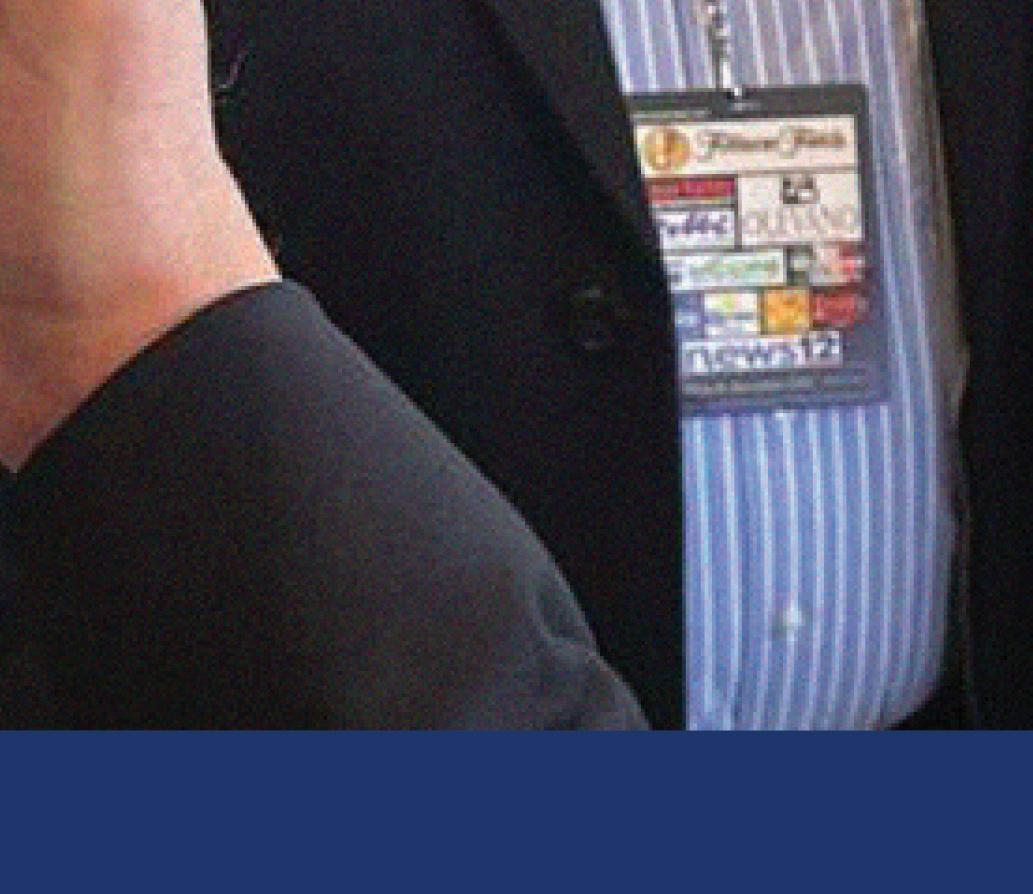











BY HENRY M. HOLDEN STAFF WRITER
AREA - New Jersey played a significant role in the American fight for independence. There were several New Jersey locations where battles were fought and where the outcomes created the atmosphere that contributed to the states’ ultimate united victory. Boston Tea Party, (December 16, 1773), was a nonviolent protest which preceded the actual shooting war. Three hundred-forty-two chests of tea belonging to the British East India Company were thrown from ships into Boston Harbor by American patriots disguised as Mohawk Indians. The Americans were protesting both taxation without representation and the perceived monopoly of the East India Company.
With 165 principal engagements from 1775-1783, the Revolutionary War was the catalyst for American independence.
The American Revolution was an insurrection carried out by 13 American colonies that began in 1775 and ended with a peace treaty in 1783.
The first clash began on April 19, 1775, when more about 700 British soldiers were given what they thought were secret orders to destroy colonial military supplies in Concord, Massachusetts. Fortunately, and thanks to a sophisticated colonial intelligence network, led by the Sons of Liberty, the Patriots were aware that their supplies were at risk, and were able to move them before the British arrived. Also, thanks to the daring rides of the Sons of Liberty, the colonial militia knew that an engagement with the British Army was imminent.
There were five riders who collectively enabled the Colonists to make ready for an attack. But poets, historians, educators, and history buffs have retold the story of the legendary ride, of Paul Revere for more than two centuries. The most popular retelling is the poem entitled “Paul Revere’s Ride” by Henry Wadsworth Longfellow. It begins:
Listen my children and you shall hear Of the midnight ride of Paul Revere, On the eighteenth of April, in Seventy-five; Hardly a man is now alive
Who remembers that famous day and year.
Paul Revere was born in Boston in 1734, to a French Huguenot father and a Bostonian mother. He started his young life training to be a silversmith. After the death of his father in 1754, Revere enlisted in the provincial army to fight in the French and Indian War because was it was the best paying job available at the time.
When the war was over, he returned to Boston to take over his father’s silversmith busi-
ness, only to fall into financial challenges during the Stamp Act of 1765.
This Act was the first internal tax levied directly on American colonists by the British Parliament. The act, which imposed a tax on all paper documents in the colonies, came at a time when the British Empire was deep in debt from the Seven Years Wars (1756-63) and was looking to its North American colonies as a revenue source. The angry mobs resulted in its repeal in 1766.
Frustrated by this gave Revere a reason to join the Sons of Liberty, a group of men initially responsible for organizing early revolutionary efforts and develop a close association with them.
On April 18, 1775, Joseph Warren, one of the Sons of Liberty, sent Revere to send the signal to Charlestown that the British troops were on the move. Revere rode through northern Boston, through what is now Medford, Somerville, and Arlington warning the American patriots about the enemy’s movement.
Contrary to popular beliefs, Paul Revere never shouted the phrase “the British are coming,” and instead rode swiftly and in secrecy northward. His journey ended in Lexington where he met other Sons of Liberty, such as John Hancock and other like-minded patriots.
In the 250+ years since its independence, the United States of America has developed into a thriving nation, based on the articulated freedoms of life, liberty, and the pursuit of happiness. Yet not every aspect of the Revolutionary Period is full of bright morals and good behavior.
When Britain imposed the Intolerable Acts throughout the 1750s and 60s, a great number of men became extremely angry, and began to act violently against British Loyalists in the colonies.
In response to colonial resistance to British during the winter of 1773–74, they were determined to reassert their authority in America and passed four acts that were known as the Coercive Acts in Britain but were labeled the Intolerable Acts by the colonists.
The Coercive Acts, were passed by Parliament in 1774, in response to colonial resistance to the British rule. The four acts were (1) the Boston Port Bill, which closed Boston Harbor; (2) the Massachusetts Government Act, which replaced the elective local government with an appointive one and increased the powers of the military governor; (3) the Administration of Justice Act, which allowed British officials charged with capital offenses to be tried in another colony or in England; and (4) the Quartering Act, which permitted the requi-
sition of unoccupied buildings to house British troops, and more mobs sprang up all over the colonies, reigning terror on those who remained faithful to the crown.
The displays of American patriotism, as exhibited by the great war in 1776, one may to think of the great names which are prominently recorded in history. Such names as Washington, Jefferson, Lafayette, Kosciusko, are likely to draw all the attention, while others, equally meritorious in self-denial and endurance receive no mention. One of these groups would be a secret Boston association of elite gentlemen, mainly law men and artisans, who met discretely to organize ways to begin to effectively oppose the actions of the crown.
The Loyal Nine were responsible for putting boundaries on the rampant violence of Boston and set limits on how far the demonstrations should progress. They actively stood against British policies they found to be immoral and unlawful and had their hands in projects such as the Boston Tea Party.
As time progressed, and frustration with the British crown began to heat up in the colonies, the Loyal Nine merged into the more famous organization known as the Sons of Liberty. The prominent members of this group were Samuel Adams, Joseph Warren, Paul Revere, and Benedict Arnold. John Hancock is most remembered for his singular classic name scrawled on the Declaration of Independence
The second cousin of John Adams, Samuel Adams was a Massachusetts statesman, founding father, and firm voice of the American Revolution. He was one of the main forces behind the American movement for Independence and was infamous for his role in the turmoil in Boston in the years leading up to the Revolutionary War. Where John Adams was strong spirited, Samuel was practically virulent, a master of propaganda and an instigator of mob violence. He had few qualms about acting in opposition to the British authorities, especially on issues he deemed to be “unfair” to the American colonists. His strong leadership inspired the New England colonies to take up arms against the crowns oppressors, and he continued to be a central figure throughout the latter part of the eighteenth century.
A notorious traitor to the revolutionary cause, Benedict Arnold started his political career as a Son of Liberty. As a pharmacist and bookseller in New England, Arnold fell into financial struggles after the introduction of the Intolerable Acts. He did not engage in any popular demonstrations but became a smuggler and continued

passed on the colonial form of the black market.
Despite his early activity to oppose the British crown, and his relative success as a Revolutionary War General, Arnold eventually came to lose faith in the American cause, would change sides and join the British against the American colonies halfway through the war.
In 1780, Arnold was given command of West Point, an American fort on the Hudson River in New York (and future home of the U.S. military academy, established in 1802).
Arnold contacted Sir Henry Clinton, head of the British forces, and proposed handing over West Point and his men.
On September 21, Arnold met with Major John Andre and made his traitorous pact. However, the conspiracy was uncovered, and Andre was captured and executed. Arnold, the former American patriot, fled to the enemy side and went on to lead British troops in Virginia and Connecticut. He later moved to England, though he never received all of what he’d been promised by the British. He died in London on June 14, 1801.
Battle of Trenton
On the night of December 25–26, 1776, General George Washington, , led 2,400 men across the Delaware River. After a nine-mile march, they seized the town of Trenton on the morning of December 26,
killing or wounding over 100 (Hessians were German soldiers who served as mercenaries in several major wars in the 18th century, most notably the American Revolutionary War) and capturing 900 more.
Soon after capturing the town, Washington led the army back across the Delaware into Pennsylvania. On December 29, Washington once again led the army across the river and es-
tablished a defensive position at Trenton.
On December 31, Washington appealed to his men, whose enlistments expired at the end of the year, «Stay for just six more weeks for an extra bounty of ten dollars.» His appeal worked, and most of the men agreed to stay. Also, that day, Washington learned that ConPLEASE SEE SHOT HEARD, PAGE 5








gress had voted to give him wide-ranging powers for six months that are often described as dictatorial.
On the night of December 25–26, 1776, General George Washington, , led 2,400 men across the Delaware River. After a nine-mile march, they seized the town of Trenton on the morning of December 26, killing or wounding over 100 (Hessians were German soldiers who served as mercenaries in several major wars in the 18th century, most notably the American Revolutionary War) and capturing 900 more. Soon after capturing the town, Washington led the army back across the Delaware into Pennsylvania. On December 29, Washington once again led the army across the river and established a defensive position at Trenton. On December 31, Washington appealed to his men, whose enlistments expired at the end of the year, «Stay for just six more weeks for an extra bounty of ten dollars.» His appeal worked, and most of the
men agreed to stay. Also, that day, Washington learned that Congress had voted to give him wide-ranging powers for six months that are often described as dictatorial.
Battle of Princeton The Battle of Princeton was fought on January 3, 1777, and ended in a victory for the Colonists. General Lord Cornwallis had left 1,400British troops under the command of Lieutenant Colonel Charles Mawhood, in Princeton. Following a surprise attack at Trenton early in the morning of December 26, 1776, General Washington decided to attack the British in New Jersey before entering the winter quarters. On December 30, he crossed back into New Jersey. His troops followed on January 3, 1777. Washington advanced to Princeton by way of a back road, where he pushed back a smaller British force but had to retreat before Cornwallis arrived with reinforcements. The battles of Trenton and Princeton boosted the morale of the patriot cause, leading many recruits to join the Continental
Army in the spring.
After defeating the Hessians at the Battle of Trenton on December 26, 1776, Washington withdrew back to Pennsylvania. He subsequently decided to attack the British forces before going into winter quarters. On December 29, he led his army back into Trenton. On the night of January 2, 1777, Washington repelled a British attack at the Battle of the Assunpink Creek. That night, he emptied his position, circled General Cornwallis’ army, and attacked the British garrison at Princeton.
On January 3, Brigadier General Hugh Mercer of the Continental Army clashed with two regiments under the command of Mawhood. Mercer and his troops were overrun, and Mercer was mortally wounded. Washington sent a brigade of militia under Brigadier General John Cadwalader to help them. On seeing the flight of Mercer’s men, the militia began to flee. Washington rode up with reinforcements and rallied the fleeing militia. He then led the attack on Mawhood’s troops, driving them back. Mawhood gave the order to retreat, and most of the troops tried to flee to Cornwallis in Trenton.
In Princeton, Brigadier General John Sullivan encouraged some British troops who had taken refuge in Nassau Hall to surrender, ending the battle. After the battle, Washington moved his army to Morristown, and with their third defeat in 10 days, the British left Central Jersey. The battle (was the last major action of Washington’s winter New Jersey campaign.
Following the loss at Trenton, General Cornwallis departed New York City and gathered a British force of over 9,000 at Princeton to counter Washington. Leaving 1,200 men under the command of Lieutenant Colonel Mawhood at Princeton, Cornwallis left Princeton on January 2, commanding 8,000 men to confront Washington’s army of 6,000 troops.
Washington dispatched troops to engage with the advancing British to delay their progress. By the time the British arrived at Trenton, it was almost nightfall. After three unsuccessful attempts to cross the bridge over the Assunpink Creek, where the primary American defenses were located, Cornwallis postponed the attack until the following day.
Mawhood ordered his troops to delay Mercer, while he brought up the other detachments. Mercer was walking through William Clark’s orchard when the British troops appeared. The British troops’ volley went high, which gave time for Mercer to wheel his
troops around into battle line. Mercer’s troops advanced, pushing back the British light troops. The Americans took up a position behind a fence at the upper end of the orchard. However, Mawhood had brought up his troops and his artillery. The American gunners opened fire first, and for about ten minutes, the outnumbered American infantry exchanged fire with the British. However, many of the Americans had rifles which took longer to load than muskets. Mawhood ordered a bayonet charge, and because many of the Americans had rifles, which could not be equipped with bayonets, they were overrun. Both Americans’ cannon were captured, and the British turned them on the fleeing troops. Mercer was surrounded by British soldiers, and they shouted at him “Surrender, you damn rebel!” Declining to ask for quarter, Mercer chose to resist instead. The British, thinking they had caught Washington, bayoneted him and then left him for dead. Mercer’s second in command, was shot through the head and killed.
After entering Princeton, the Americans began to loot the abandoned British supply wagons and the town. With news that Cornwallis was approaching, Washington knew he had to leave Princeton. Washington wanted to push on to New Brunswick and capture a British pay chest of 70,000 pounds, 90 but Major Generals Henry Knox and Nathanael Greene talked him out of it. Instead, Washington moved his army to on the night of January 3, then marched to Pluckemin by January 5, and arrived at Morristown by sunset the next day for winter encampment.
[ After the battle, Cornwallis abandoned many of his posts in New Jersey and ordered his army to retreat to New Brunswick. The next several months of the war consisted of a series of small-scale skirmishes known as the Forage War
The Battle of Monmouth
On June 28, 1778, in what is now Monmouth Battlefield State Park, was one of the longest battles of the American Revolutionary War took place on a scorching hot day. It was
a pivotal moment for Washington, marking a crucial turning point in the War. This success dispelled doubts about his leadership, solidified his command over the army, and protected him from serious public criticism for the rest of the war.
In a day-long battle across hills, fields, and meadows, the retrained Continental Army repelled attacks by the British Army. By the end of the battle, over 600 men were dead or wounded, and the Continental Army held the field.
The battles, spanning December 26, 1776, to January 3, 1777, marked General George Washington’s first victories.
The Battle of Monmouth was crucial as it marked the debut of the American Army after training at Valley Forge. The Continental Army, now a cohesive unit with new confidence, proved their training had paid off. Holding the field the next day convinced the British to withdraw and continue to New York City.
Jockey Hollow
During the Revolutionary War, Henry Wick an American Colonist dominated the largest portion of this area—his farm comprised 1400 acres of timber and open field. The Wick farm and his neighbors’ property were considered the ideal location for a winter camp due to the distance from British forces in New York and the amount of timber needed for shelter and firewood for a large army, and the availability of houses for officers, mainly generals and their staff, to quarter.
During the winter of 1779–1780, approximately 600 acres of timber in Wick’s land and about 2,000 acres total in Jockey Hollow were cut down by the soldiers to be used for the construction of huts and as firewood.
Molly Pitcher
During battles, there were colonial women who carried water to thirsty American soldiers on the battlefield. They were given the nickname “Molly Pitcher.” At the Battle of Monmouth, legend has it that a woman from Philadelphia named Mary Ludwig Hays carried water to the men. When her husband, who was
with the artillery, was injured, she supposedly took his place on the battlefield and helped fire on the British.
Morristown
The Green has been at the center of Morristown for over two and a half centuries. When General Washington took his headquarters at the Jacob Arnold tavern during the 1777 winter encampment, the Green became a hub of military activities. Various buildings around it were used as officers’ headquarters, army hospitals, and a military store house. Opposite the Arnold Tavern site on the North Park Place side of the park, is a monument to mark the site of the courthouse and jail that stood here at the time of the Revolutionary War. There were shortages of food and other provisions which posed a serious challenge for the army at Morristown. Fresh meat was usually unavailable, and shortages of flour often made bread scarce. Washington noted that the soldiers sometimes went “five or six days together without bread, at other times as many days without meat, and once or twice two or three days without either, a situation made worse by the fact that Morristown was located amidst numerous local farms. Despite their proximity to the farmland, however, drought had created shortages in the harvest seasons before, and farmers were often unwilling to give up their crops to feed soldiers. Many farmers had cut back on the number of acres they were cultivating as the war progressed. This was due to the poor prices the Continentals offered for goods. The inclement weather added to the difficulty in transporting available supplies to the army. Community members’ restraint to offer their support to the Continental Army provided a constant source of frustration for the Commander-In-Chief. Though Washington was scorned to anger locals by allowing his troops to pillage their farms and fields, he eventually permitted the confiscation of grain and cattle from nearby properties to keep his troops from starving.


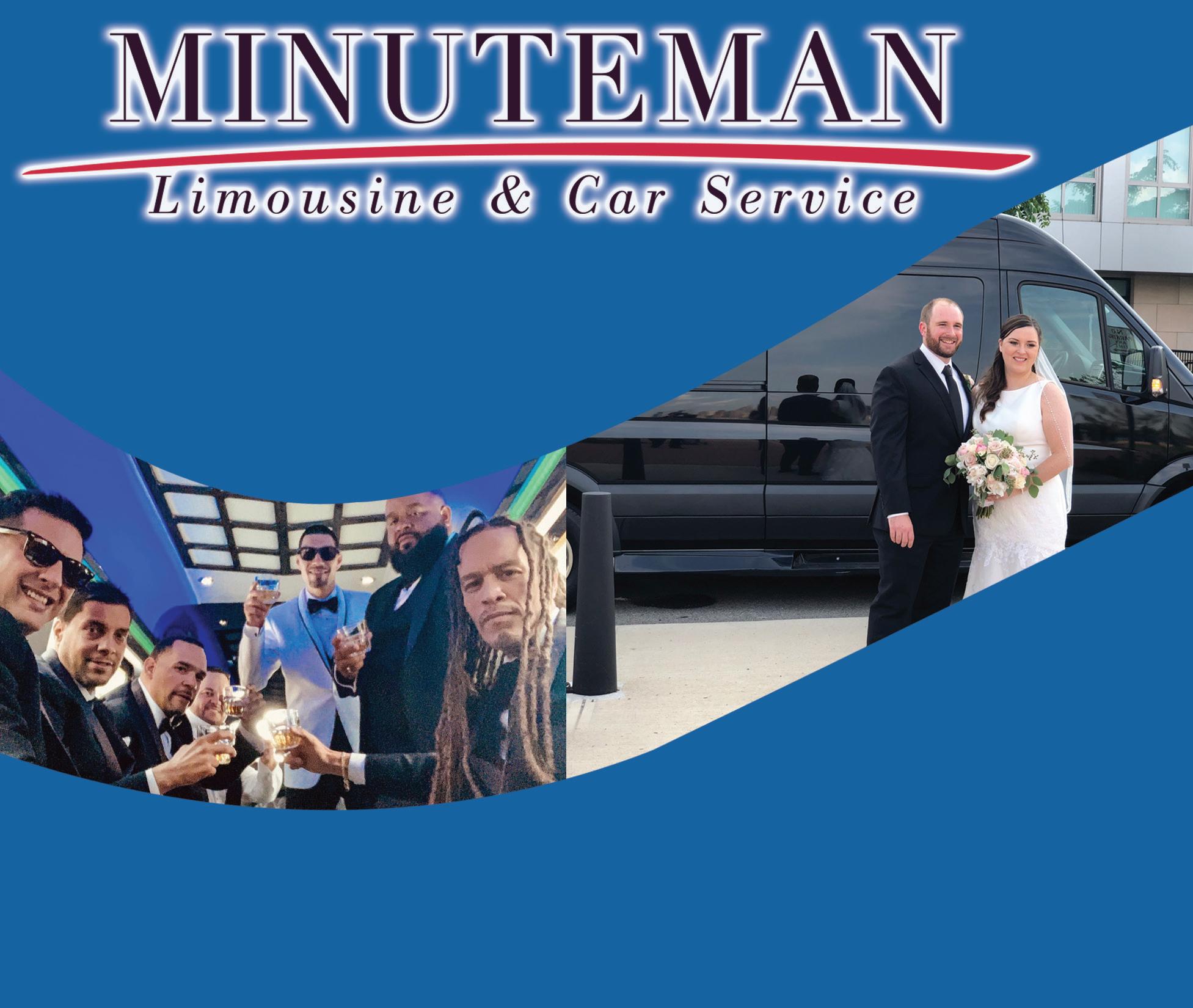
AREA - When buying a child’s first bike, shoppers should prioritize a bike that is lightweight, which will be easier for the child to maneuver while learning. The general rule of thumb is to find a bike that weighs less than one-third of the child’s overall weight. Choose a bike that has minimal features, and opt for models that have a single gear and no complex braking systems. The child should be able to comfortably straddle the bike with their feet flat on the ground,
and the seat height should be set where the child’s legs are slightly bent at the bottom of the pedal stroke. According to BikeExchange.com, the first bike a child owns likely will feature 12-inch tires and will often come with optional training wheels. Children between the ages of two and five may progress to 14-inch tires and then increase that size as they grow and gain experience. Although it can be less expensive to purchase a child’s bike at a big box retailer, more personalized






























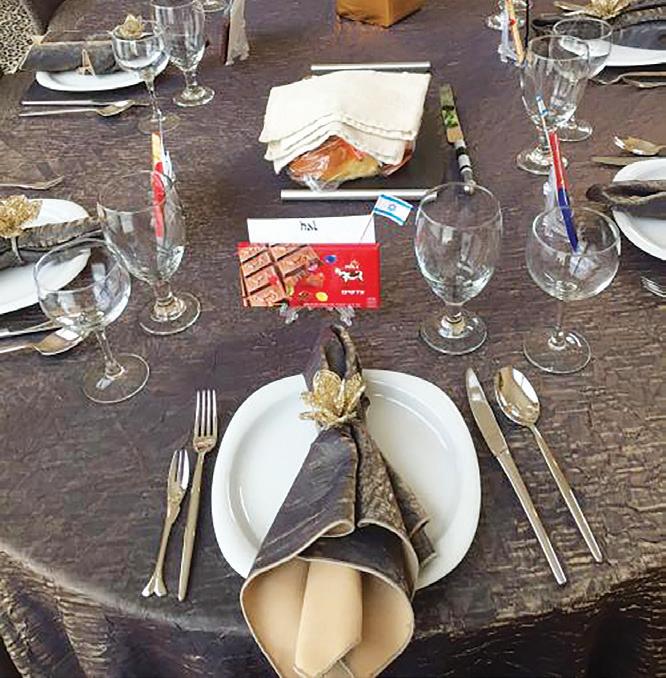





BY RICHARD MABEY, JR. GUEST WRITER
AREA - This is the third condensed chapter of the book that I am presently writing, about my journey to earn scouting’s highest rank, Eagle Scout. This is a true story.
In 1966, Lincoln Park was very much a different place than it is now. To the best of my memory, I don’t think that there was a single street light in the entire town. The town was more of a village than a suburban town. There were more farms back then. And, it seems that half of the town’s acreage was filled with forest land. And truly it seemed, everyone was related to everyone else, in some form or another.
In early September of 1966, I turned 13 and began the eighth grade at Chapel Hill School. It was a tough time for me. I had not attended school for practically all of seventh grade, being in and out of three long-term stays at the Barnert Hospital in Paterson, fighting off a fullblown case of Rheumatic Fever. So, when I began the eighth grade, I was not the strongest kid in my class. I was not the most coordinated, by any means. And, I wasn’t that good at sports.
The two things that brought great joy to my heart, were church youth group and scouts. At the baseball field of old Chapel Hill School, I was the strike-out king, but I could shine like a diamond in church youth group and scouts. And in scouts, one thing burnt brightly in my heart, the dream of becoming an Eagle Scout.
I loved reading the little Merit Badge Pamphlets. They were composed of 8½ by 11 inch paper, folded in half. Each Merit Badge Pamphlet ran between 40 to 60 pages in length. And, there were dozens upon dozens of these wonderful little booklets

to read. One such Merit Badge Pamphlet struck a chord within my heart and mind. It was the Conservation of Natural Resources, Merit Badge Pamphlet. I remember that it was quite a bit thicker than most of the other Merit Badge Pamphlets. If I remember right, it was more than a hundred pages long.
While I was in the eighth grade, I must have read that booklet more than a dozen times. I planted a dogwood tree along Mabey Lane. I built a bird feeder and bird house and kept a daily log of the bird activities. And, I studied and studied the importance of conservation of our natural resources.
I remember that a scout had to write an essay about the importance of conserving our natural resources for this particular merit badge. I remember that Mom loaned me her pride and joy, Underwood Typewriter, so that I could type up my essay.
I remember that my essay ran well over 10 pages in length. My dad bought me a plastic cover to put my essay in. I was incredibly proud of that essay.
My fellow scout, Donald Stone and I attended the classes together, for the Conservation of Natural Resources Merit Badge. It was after one of the class-





es, that was held at the Merit Badge Counselor’s home, that we waited for my dad to pick us up to take us home. There in the midst of our Counselor’s driveway, we made a pledge that we both would make Eagle Scout, no matter what. We even shook hands on it, thus cementing the agreement in concrete. We both kept our vows. We both earned the coveted rank of Eagle Scout. Now at 71, I look back at those days of innocence with great fondness. Although, a certain sadness fills my heart. It seems like I blinked my eyes and that 13 year old boy, became an old man. None of us can stop the clicking of the clock.
I now look back at how hard I worked on my Conservation of Natural Resources essay. I think that writing that essay was an important step in my growth to develop a deep love for putting words down on paper. It was an important step to my staircase journey to earning scouting’s highest rank. To be continued.
Richard Mabey Jr. is a freelance writer. He has had two books published. He hosts a YouTube Channel titled, “Richard Mabey Presents.” He can be reached at richardmabeyjr@ gmail.com.
















